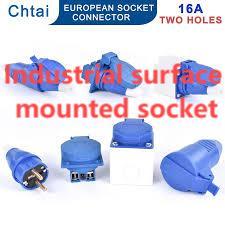Industrial Surface Mounted Socket Innovation By NANTE

In modern manufacturing and facility upgrades, specifying the right connection hardware early can prevent costly downtime, especially when an Industrial surface mounted socket must fit into modular layouts and when an Industrial surface mounted socket can be selected to simplify maintenance cycles. Careful planning around mounting method, protection level, and service access ensures a smooth installation and long-term reliability for production floors, assembly lines, and portable power systems.
Why Surface-Mounted Systems Matter Today
Surface-mounted power points let engineers add or relocate outlets without cutting into structures or interrupting finishes. This flexibility supports fast reconfiguration of assembly cells, temporary test rigs, or rental machinery setups. For facilities that embrace lean layouts and frequent line-changeovers, surface-mounted options reduce labor, accelerate commissioning, and keep inspection points visible for quick safety checks.
Key Mechanical and Electrical Design Considerations
Durability starts with material choice: impact-resistant housings, reinforced mounting plates, and corrosion-protected contacts extend service life. Internally, terminal spacing, strain-relief design, and secure earthing paths reduce the risk of loose connections and overheating. From an electrical viewpoint, ensure the socket matches local wiring standards, overcurrent protection schemes, and any specific harmonic or inrush characteristics of connected motors or drives.
Installation Best Practices and Accessibility
Installers benefit when products include clear mounting templates, captive fasteners, and generous internal clearance for cable bends. Elevating sockets slightly above floor level helps avoid contamination in wash-down or dusty environments. Where possible, locate sockets near inspection aisles to enable quick visual checks and tool access without moving heavy machinery. Thoughtful labeling and color-coded circuits also speed troubleshooting and reduce human error during shift changes.
Serviceability, Testing, and Safety Protocols — Nante Focus
Routine maintenance is simplified by designs that allow tool-free access to terminals and replaceable sealing gaskets. Implement a qualified inspection schedule that includes torque checks, contact resistance measurements, and thermal imaging after initial commissioning and at scheduled intervals. These tests catch early degradation before it becomes a failure. Training technicians on safe isolation procedures and correct connector handling further reduces incident risk on busy production floors.
Future-Proofing and Lifecycle Value
As factories adopt smarter power distribution and more frequent retooling, choose sockets that accommodate accessory modules, such as inlet adapters, blanking plates, or surge suppression inserts. Modular designs lower total cost of ownership by enabling incremental upgrades rather than wholesale replacement. Consider life-cycle factors—warranty terms, parts availability, and supplier support—when specifying systems intended to operate reliably for many years.
Well-specified surface-mounted sockets combine mechanical toughness with electrical integrity, supporting both routine operations and rapid reconfiguration when business needs change. By prioritizing installation accessibility, protection against environmental hazards, and straightforward maintenance procedures, facilities can reduce unplanned downtime and improve worker safety. For product families, technical resources, and installation guides, visit www.nante.com
- Art
- Causes
- Crafts
- Dance
- Drinks
- Film
- Fitness
- Food
- Игры
- Gardening
- Health
- Главная
- Literature
- Music
- Networking
- Другое
- Party
- Religion
- Shopping
- Sports
- Theater
- Wellness


